Starting a Car with Low Compression: Tips and Tricks

Low compression in a car engine refers to a situation where the pressure of the air-fuel mixture inside the engine’s cylinders is lower than the manufacturer’s specified range. This can lead to a variety of performance issues, including reduced power, poor fuel economy, and difficulty starting the engine. Low compression can be caused by a number of factors, including worn piston rings, damaged valves, or a blown head gasket. When the compression in the cylinders is low, the engine may struggle to generate enough power to propel the vehicle, leading to sluggish acceleration and overall poor performance.
Low compression can also result in poor fuel combustion, which can lead to increased emissions and reduced fuel efficiency. In severe cases, low compression can even cause the engine to misfire or stall altogether. It’s important to address low compression issues as soon as they are detected, as they can lead to further damage to the engine if left untreated. Understanding the causes and symptoms of low compression is crucial for maintaining the health and performance of your car’s engine.
Checking for Signs of Low Compression
There are several signs that may indicate low compression in a car engine. One of the most common symptoms is difficulty starting the engine. If the engine cranks but struggles to turn over, it may be a sign that the compression in one or more cylinders is too low. Another sign of low compression is reduced power and performance. If your car feels sluggish and struggles to accelerate, it may be due to low compression in the cylinders. Additionally, poor fuel economy and increased emissions can also be indicators of low compression.
To check for low compression, a mechanic can perform a compression test using a specialized tool called a compression gauge. This test involves removing the spark plugs and inserting the gauge into each cylinder to measure the pressure of the air-fuel mixture. If the readings are lower than the manufacturer’s specified range, it may indicate low compression. It’s important to address these signs promptly to prevent further damage to the engine and ensure optimal performance.
Tips for Starting a Car with Low Compression
Starting a car with low compression can be a challenging task, but there are a few tips that may help improve the chances of getting the engine running. One approach is to use a higher octane fuel, as it can help improve combustion and provide a little extra power to compensate for the low compression. Additionally, using a fuel additive designed to improve engine performance and combustion may also help improve starting and overall performance.
Another tip is to ensure that the battery is in good condition and fully charged, as a weak battery can make it even more difficult to start an engine with low compression. It’s also important to ensure that the ignition system is in good working order, as a weak spark can further exacerbate starting issues. Finally, if the weather is cold, using a block heater or warming up the engine before attempting to start it can help improve the chances of success.
Using Compression Boosters and Additives
“`html
| Product | Compression Boost | Additives |
|---|---|---|
| Brand A | Yes | No |
| Brand B | Yes | Yes |
| Brand C | No | Yes |
“`
There are several products on the market designed to help boost compression and improve engine performance. Compression boosters and additives are formulated to help seal worn piston rings and valves, which can help improve compression and restore power to an engine with low compression. These products typically contain special additives that help lubricate and condition the internal components of the engine, helping to reduce friction and improve sealing.
Using a compression booster or additive can be a cost-effective way to address low compression issues without having to resort to more expensive repairs. However, it’s important to follow the manufacturer’s instructions when using these products, as using too much can lead to other issues such as fouled spark plugs or clogged fuel injectors. Additionally, while these products may provide temporary relief from low compression, they are not a permanent solution and may not be suitable for all types of low compression issues.
Seeking Professional Help for Low Compression Issues
While there are some steps that car owners can take to address low compression issues on their own, it’s often best to seek professional help when dealing with engine problems. A qualified mechanic can perform a thorough diagnosis of the engine to identify the root cause of the low compression and recommend appropriate repairs. This may involve replacing worn piston rings, repairing damaged valves, or addressing other issues that may be contributing to low compression.
In some cases, it may be necessary to rebuild or replace the engine if the damage is severe. While this can be a costly repair, it may be necessary to ensure the long-term health and performance of the vehicle. It’s important to work with a reputable mechanic or auto repair shop that has experience dealing with low compression issues and can provide reliable service.
Preventing Low Compression in the Future

Preventing low compression in a car engine involves regular maintenance and care. It’s important to follow the manufacturer’s recommended maintenance schedule for oil changes, filter replacements, and other routine services. Keeping the engine properly lubricated and well-maintained can help reduce wear on internal components and prolong their lifespan.
Additionally, using high-quality fuel and performing regular inspections of the ignition system can help prevent issues that may contribute to low compression. It’s also important to address any signs of trouble promptly, as ignoring minor issues can lead to more serious problems down the road. By taking proactive steps to maintain the health of the engine, car owners can help prevent low compression and ensure optimal performance for years to come.
Taking Care of Your Car’s Compression Issues
Low compression in a car engine can lead to a variety of performance issues, but there are steps that car owners can take to address these problems and prevent them from occurring in the future. By understanding the causes and symptoms of low compression, checking for signs of trouble, and seeking professional help when needed, car owners can ensure that their vehicles continue to run smoothly and efficiently.
Using compression boosters and additives may provide temporary relief from low compression, but it’s important to address underlying issues with professional help when necessary. By taking proactive steps to maintain the health of the engine and addressing any signs of trouble promptly, car owners can help prevent low compression and ensure optimal performance for years to come. Regular maintenance and care are key to preventing low compression and keeping your car running smoothly for years to come.
If you’re struggling to start a car with low compression, you may want to check out this article on howtostart.digital. The article provides helpful tips and tricks for getting your car up and running despite low compression issues. Whether it’s troubleshooting the problem or finding alternative methods to start your car, this article has got you covered. Check it out here for more information.
FAQs
What is low compression in a car?
Low compression in a car refers to a situation where the pressure of the air-fuel mixture in the engine’s cylinders is lower than the manufacturer’s specified level. This can result in various issues such as difficulty starting the car, reduced power, and poor fuel efficiency.
What are the common causes of low compression in a car?
Common causes of low compression in a car include worn piston rings, damaged or worn cylinder walls, leaking or damaged valves, a blown head gasket, or a warped cylinder head.
How can I start a car with low compression?
To start a car with low compression, you can try the following steps:
1. Use a high-quality starter motor to provide sufficient cranking power.
2. Use a fully charged battery to ensure the engine turns over at the required speed.
3. Use a fuel additive to improve the combustion process and help the engine start more easily.
4. Consider using a thicker engine oil to help improve compression and reduce oil consumption.
Can low compression be fixed?
In some cases, low compression can be fixed by repairing or replacing the damaged components such as piston rings, cylinder walls, valves, head gasket, or cylinder head. However, the extent of the damage and the cost of repairs may make it more practical to replace the engine altogether.
What are the signs of low compression in a car?
Signs of low compression in a car may include difficulty starting the engine, rough idling, misfiring, loss of power, poor fuel efficiency, and excessive oil consumption. If you notice any of these symptoms, it’s important to have your car inspected by a qualified mechanic.





